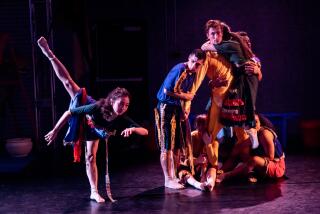Aboriginal Troupe Updates Ancient Style
- Share via
Australian aboriginal culture takes us on an unbroken path back to prehistory, a journey that choreographer Stephen Page invokes with an exciting sense of contemporary stagecraft in “Corroboree” for his Sydney-based Bangarra Aboriginal Dance Theatre.
Combining ancient stamping and shuffling dances with a modern dance vocabulary, and juxtaposing traditional chants and stick percussion with rock and techno-pop, “Corroboree” arrived in an abridged hourlong version Saturday at El Camino College in Torrance. Gone was the “Nesting” section seen in New York and Washington because its set reportedly proved too cumbersome to take on tour.
Gone, too, were the profanity and protest in the “Roo” section; a late arrival in Southern California made it impossible for the company to prepare the technical portion of this sequence involving simulated rain and depictions of what the house program called “social abuse.” (“Roo” also was shortened in this way in North and South Carolina.)
What remained abstracted ancestral life in vignettes depicting the struggle for survival, the connection with the natural world and the unity of aboriginal society. Culled for this U.S. tour from a number of Page’s works, these vignettes gained cohesion from the strength and authority of Bangarra’s 12 dancers, plus the unique presence of Djakapurra Munyarryun as clan elder and link to the spiritual legacy of the past.
In the opening sequence, Munyarryun sat under a falling mist of white clay dust, looking as if he’d been carved from that clay eons ago. In the finale, he painted himself with white ochre and joined the other whitened dancers in a statement of death and renewal.
White dust and fog also gave other sections a pale, smoky atmosphere, and the layering of past and present in the taped music by David Page and Steve Francis suggested unchanging conditions of life in a harsh landscape. But some of the rhythmic unison choreography to pop accompaniment veered uncomfortably close to MTV-style trivialization of world cultures--as if 40,000 years of human evolution existed only to bring us a hard-sell display of aboriginal hip-hop.
More often, happily, “Corroboree” stayed grounded in compelling animal motion and powerful belief systems, as in the “Dingo” ritual of initiation that juxtaposed Russell Page’s gymnastic body lashing with ceremonial processions by five other men and intense scrutiny by Munyarryun.
Sidney Saltner’s fluid “Cocoon” solo further demonstrated Stephen Page’s skill at floor-based modern dance choreography. Indeed, except for a few lifts and other diversionary partnering gambits near the end, his ability to utterly avoid ballet as a reference point, culturally or technically, gave “Corroboree” a distinctive stance quite apart from its use of aboriginal resources. Modern dance with a sense of self-reliance is rare enough, and modern dance informed by a sense of mission seems almost miraculous.
With all its lapses and losses in Torrance, “Corroboree” confirmed intercultural expression as a profound dialogue and a vehicle for growth. But it didn’t allow us to take the measure of Page’s talent. To do that, we’d need to see something exactly as he conceived it--unabridged, uncompromised and uncensored.
More to Read
The biggest entertainment stories
Get our big stories about Hollywood, film, television, music, arts, culture and more right in your inbox as soon as they publish.
You may occasionally receive promotional content from the Los Angeles Times.










